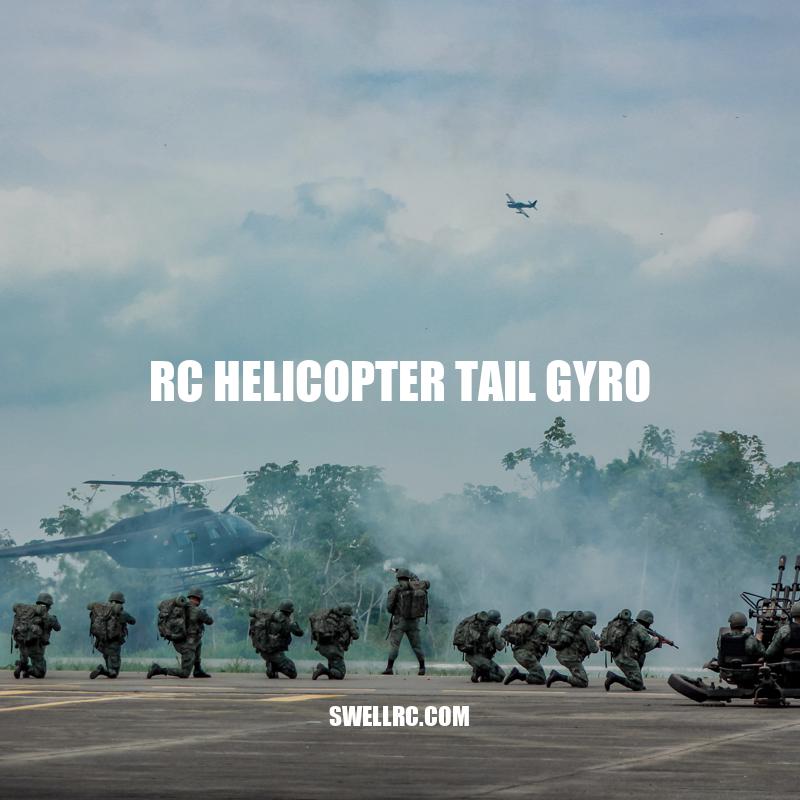RC Helicopter Tail Gyro: Maintaining Stability in Flight
RC helicopters have become increasingly popular among hobbyists and enthusiasts. Flying an RC helicopter can be a thrilling experience, but it requires skill and precision. One of the key components that make RC helicopters fun to fly is the tail gyro. The tail gyro plays a crucial role in maintaining the stability of the RC helicopter during flight. It helps to counteract the torque produced by the main rotor, allowing the helicopter to remain level and upright. Without a tail gyro, flying an RC helicopter can be extremely difficult and prone to crashes. The tail gyro works by sensing any changes in the helicopter’s yaw rate and adjusting the tail rotor’s pitch to correct the helicopter’s orientation. In this article, we will discuss everything you need to know about the RC helicopter tail gyro, including its function, types, factors to consider when choosing one, installation tips, as well as the best tail gyros available in the market.
The RC helicopter tail gyro is an electronic device that plays a crucial role in maintaining the stability of the helicopter during flight. It is located in the tail section of the helicopter and works by sensing any changes in the helicopter’s yaw rate and adjusting the tail rotor’s pitch to correct the helicopter’s orientation. Here are some important things to know about the RC helicopter tail gyro:
- It is connected to the receiver and the tail rotor servo.
- The tail gyro receives signals from the receiver and sends them to the tail rotor servo to adjust the pitch of the tail rotor blades.
- It helps to counteract the torque produced by the helicopter’s main rotor, which tends to spin the helicopter’s body in the opposite direction.
- It is essential for stable and safe flight and helps to prevent the helicopter from spinning out of control.
There are different types of RC helicopter tail gyros available in the market, each with its own set of pros and cons. In the next section, we’ll take a closer look at some of these types and their features.
Some types of tail gyros include Futaba gyros, which are known for their precision and advanced features, and Spektrum gyros, which are popular among beginners for their simplicity and ease of use. Other notable manufacturers of tail gyros include Align and Hitec.
When choosing a tail gyro, it is important to consider factors such as price, features, and compatibility with your helicopter’s receiver and servo. Some gyro models come with advanced features such as heading hold and gyro gain adjustment, which can help improve the helicopter’s performance and stability. Additionally, some high-end gyros are designed for specific types of helicopter, such as 3D aerobatic models or scale models.
In summary, the RC helicopter tail gyro is an essential component of any helicopter and plays a critical role in maintaining stability and control during flight. With various types of gyros available in the market, it is important to choose one that best fits your needs and budget.
What is gyro on a helicopter?
A helicopter gyro is a device that detects any movement of the helicopter in the left or right direction, also known as yaw movement. As soon as it senses any such movement, it automatically sends a corrective command to the tail rotor servo to limit or stop the yaw movement. This device is particularly important for RCRC (Radio-Controlled) helicopters that require precision and stability during flight. For more information on radio control systems, you can check out the Wikipedia page on Radio Control.
Types of RC Helicopter Tail Gyros
There are several different types of RC helicopter tail gyros available in the market. Here are some of the most common types:
| Type | Features | Pros | Cons |
|---|---|---|---|
| Rate Gyro | Uses a potentiometer to sense changes in the helicopter’s orientation and adjusts the tail rotor’s pitch accordingly. | Simple design, affordable price. | Not as accurate as other types, not as effective in windy conditions. |
| Heading Hold Gyro | Uses a sensor to detect the helicopter’s heading and maintains its orientation by adjusting the tail rotor’s pitch. | More accurate than rate gyros, effective in windy conditions. | More expensive than rate gyros, requires more setup and calibration. |
| Multi-axis Gyro | Uses multiple sensors to detect changes in the helicopter’s orientation along different axes. | Can provide more stability, especially in 3D flying. | Most expensive option, requires more setup and calibration. |
It’s important to choose the right type of tail gyro based on your flying style and the conditions you’re flying in. For example, a rate gyro may be sufficient for basic hovering and forward flight, but a heading hold gyro may be more effective for more advanced flying maneuvers. In the next section, we’ll discuss some important factors to consider when choosing an RC helicopter tail gyro.
One factor to consider when choosing an RC helicopter tail gyro is the brand. Some popular brands include Spektrum, Align, and Futaba. It’s important to choose a brand that has a good reputation for producing high-quality and reliable products.
Another factor to consider is the size of the gyro. Make sure to choose a gyro that is the appropriate size for your helicopter. If the gyro is too small, it may not be able to handle the weight and power of the helicopter. If it’s too large, it may not fit properly or could affect the balance of the helicopter.
Finally, consider the features offered by the gyro. Some gyros may have additional features such as built-in stabilization or programmable settings. These features can help to improve performance and make it easier to customize the gyro to your personal preferences.
By considering these factors and choosing the right type of RC helicopter tail gyro, you can improve the stability and performance of your helicopter and enjoy a more satisfying flying experience.
What causes tail wag on a RC helicopter?
The tail wag on an RC helicopter is caused by high gain. This can be identified by a continuous and rapid movement of the tail. To fix this issue, the gyro gain should be lowered until no wag is seen during flight. For further information about RC helicopters and their components, visit websites such as Horizon Hobby or HobbyKing.
Factors to Consider When Choosing an RC Helicopter Tail Gyro
When selecting an RC helicopter tail gyro, there are several important factors to consider. Here are some of the most important ones:
- Flying Style: Consider your flying style when choosing a tail gyro. If you’re a beginner, a simpler, more affordable gyro may be suitable. If you’re an advanced flier, you may need a more advanced gyro to handle complex maneuvers.
- Helicopter Size: Choose a gyro that is appropriate for the size of your helicopter. Larger helicopters may require more powerful and advanced gyros.
- Price: RC helicopter tail gyros are available at different price points. Consider your budget when choosing a gyro, but keep in mind that a higher price may result in better quality and performance.
- Features: Some tail gyros may come with additional features, such as built-in vibration compensation, programmability, and more. Consider which features are important to you when making your selection.
- Compatibility: Ensure that the tail gyro you choose is compatible with your helicopter’s other components, such as the transmitter and receiver.
- Brand: Research the brand and read reviews before making a purchase to ensure that you’re buying a reliable and reputable product.
Taking these factors into consideration will help you choose the right RC helicopter tail gyro for your needs. In the next section, we’ll discuss some tips for installing a tail gyro on your RC helicopter.
RC helicopter tail gyros come in various brands, sizes, and price points. Notable brands include Spektrum, Align, and Futaba. It’s important to note that certain gyros may be more suitable for certain helicopter models and setups.
When installing a tail gyro on your RC helicopter, ensure that it is mounted securely and in the correct orientation. It’s also important to properly configure the gyro using the manufacturer’s instructions. Failure to do so may result in poor performance or even crashes.
Overall, choosing and installing an RC helicopter tail gyro requires careful consideration and attention to detail. By following these tips, you can enhance the performance and stability of your RC helicopter during flight.
How to choose a motor for RC helicopter?
If you’re looking to choose a motor for your RC helicopter, a good rule of thumb is to go for a motor with around 250-300 watts per pound for 3D flight. For example, if your heli weighs 10lbs, including the motor and batteries, then a motor that can produce 3000 watts should work well. For more information, you may want to check out RC enthusiast websites such as RCGroups.com or product manufacturers such as Align.com.
Tips for Installing an RC Helicopter Tail Gyro
Installing a tail gyro on an RC helicopter can seem daunting, but with the right tips and guidance, it can be a relatively straightforward process. Here are some important tips to consider when installing a tail gyro:
- Read the Manual: Carefully read the manual that comes with the gyro before installing it on your helicopter. Different gyros may have different installation procedures.
- Mounting: Mount the gyro on a flat surface with double-sided tape or Velcro to reduce vibration.
- Wiring: Make sure you connect the gyro’s wiring correctly according to the manual. Crossed wiring can cause the gyro to malfunction.
- Binding: Bind the tail gyro to your transmitter according to the instructions in the manual.
- Testing: Test the gyro’s performance before going for a full flight. Make sure it’s properly calibrated and functioning as expected.
- Tweaking: If necessary, make small adjustments to the gyro’s settings to improve its performance.
Keep these tips in mind, and you should be able to install an RC helicopter tail gyro on your own. If you’re unsure about the process, consider seeking guidance from a more experienced flier or consulting online tutorials or forums. In the next section, we’ll share some of the best RC helicopter tail gyros available in the market.
What does a gyro do on a RC helicopter?
A gyro on a RC helicopter detects any left or right swinging movement of the helicopter and automatically sends a command to correct and stop/limit the yaw movement. Radio control is used to remotely control the device. For more information on RC helicopters and accessories, visit websites such as Horizon Hobby or HeliDirect.
Best RC Helicopter Tail Gyros in the Market
There is a wide variety of RC helicopter tail gyros available in the market, each with unique features and capabilities. Here are some of the best options you can consider:
| Gyro | Features | Price |
|---|---|---|
| Align DS825M |
|
$150 – $200 |
| Futaba GY701 |
|
$200 – $250 |
| Spektrum AR7210BX |
|
$250 – $300 |
| YGE-TG210HV |
|
$100 – $150 |
While these gyros vary in price and features, they are all reliable options that will ensure stable and smooth flight for your RC helicopter. When shopping for a gyro, consider your budget, the type of helicopter you have, and your level of experience flying RC helicopters. Don’t hesitate to consult online reviews or seek advice from fellow hobbyists to help you make an informed decision.
What is gyros in RC helicopter?
A gyro in an RC helicopter is a device that detects any left or right swinging movement of the helicopter and sends a command to the tail rotor servo to correct and limit the movement. This can help to stabilize the helicopter during flight. For further information on RC helicopters and radio control systems, you can check out Wikipedia’s page on radio control.
Conclusion
Investing in a high-quality tail gyro is crucial for maintaining stability in an RC helicopter during flight. The gyro works in conjunction with other components to ensure smooth and precise movement, leading to a more enjoyable and successful flying experience. When selecting a gyro, it is important to consider its performance, compatibility with your helicopter, and your own skill level. Using the information in this article, you should be able to make an informed decision and choose the best tail gyro for your needs.
However, keep in mind that the gyro is just one part of the equation. Proper maintenance, tuning, and calibration of your helicopter are also important factors that affect its flight performance. Regularly checking and adjusting the gyro, servo, and other components will help you achieve optimal results and avoid any issues while flying.
Overall, remember that flying an RC helicopter takes practice and patience. Experiment with different settings and techniques to find what works best for you and your equipment. With the right tail gyro and a bit of practice, you can enjoy precision control and thrilling flights with your RC helicopter.



